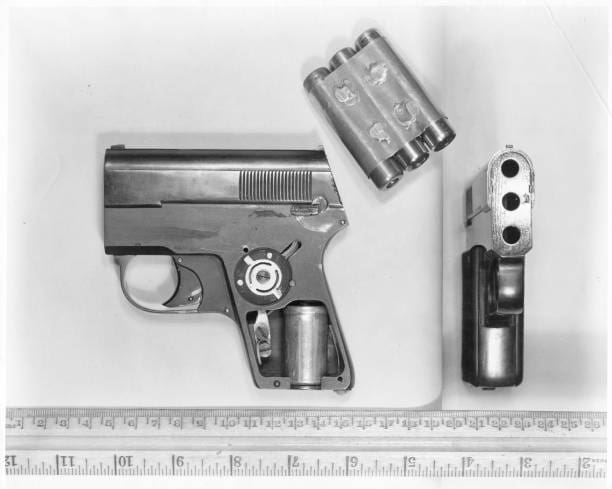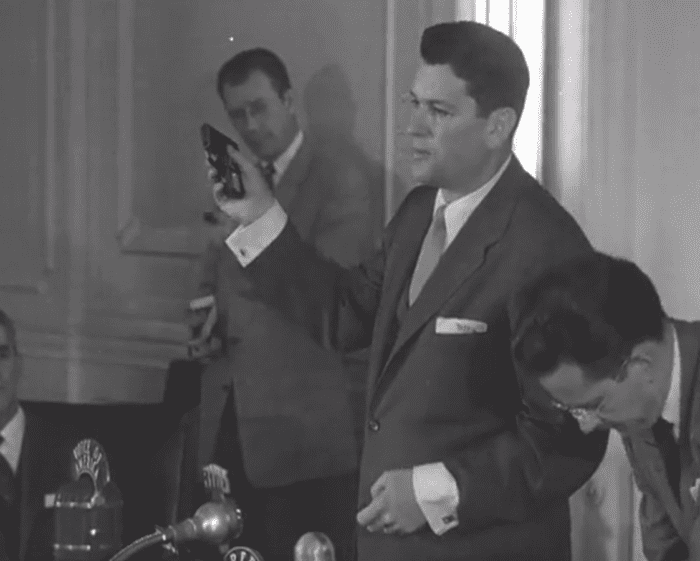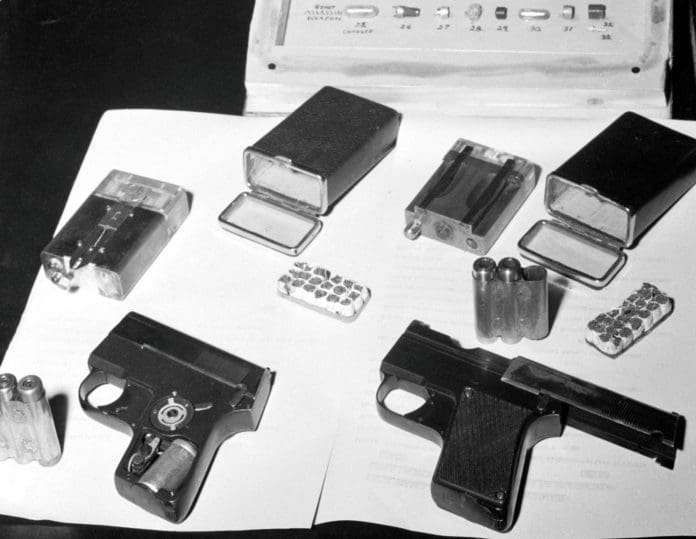The following comes from Justin at Spycraft 101 and is only a small excerpt — the most firearms-centric part — of his blog post entitled The Assassin Who Came In From The Cold:
… In May 1954, Khokhlov was the star of a shocking press conference in which he presented his story to a room packed with more than 200 reporters. The tools provided to him by the Chamber were on full display. Most famously, Khokhlov had been issued four firearms quite unlike anything else the world had ever seen.

Two of the four pistols were equipped with three single-shot .25 caliber barrels loaded with hollow point bullets filled with potassium cyanide. These poisoned rounds held a mixture of two-thirds potassium cyanide and one-third gum binder, to seal it in the hollow point of the bullet. Each round contained approximately half a gram of poison, more than 100 times a lethal dose. The rounds were locked together in a unique triple-pack that was loaded into the breach of the pistols from the top. The barrel length was negligible, so the shooter had to be very close to the target to fire. Death was virtually assured if you were struck by one of these rounds.

Perhaps more shockingly for 1954, the pistols used both an electronic ignition system powered by flashlight batteries and captive-piston ammunition; possibly the first experiment into this highly successful realm. When fired, these cartridges are nearly silent because all of the expanding gasses are captured behind a piston, which drives the bullet forward while simultaneously sealing the cartridge shut. According to Khokhlov, the sound of firing was no louder than a finger snap virtually undetectable in most environments and situations.

The other two firearms were disguised as cigarette cases, intended for a close-range attack. Khokhlov described them as “weapon blocks” which is more accurate than pistols, as they in no way resembled conventional handguns. With the case lid open, real tobacco-filled cigarette tips were visible inside, concealing the weapon’s barrel and an expansion chamber that functioned as a sound suppressor.

The case lid itself functioned as a safety to prevent an accidental or negligent discharge until the target was present. One cigarette case held two barrels, and the other four barrels. The trigger mechanism was a button on top of the case, exactly where the thumb naturally rested when holding a cigarette pack. The leather covering for the cigarette case had been shaved down on the underside to allow the assassin’s thumb to easily find the button, while hiding it from view. With no sighting mechanism, the assassin had to be right in front of the intended target. A cigarette case was the perfect tool as the assassin could approach the target with the case held out in front of him, as if to offer a cigarette. A gesture like this would be dismissed as harmless by both the target and any witnesses present.
This is the only documented deployment of these particular weapons, and only because the assassin willingly presented them to the world. Although Khokhlov describes these weapons as designed and fabricated specifically for this mission, one is left to wonder just how many times weapons like these were used by the Soviets to liquidate a target without the world ever knowing.
For all the pre- and post-story surrounding this snippet taken from somewhere near the center of the article, hop on over to Spycraft 101.





COOOOOL!!!
.gov is the largest murderer in history. And they have the cool toys to show for it.
the only creator is by far the largest exterminator. not even counting those silenced in his name.
Now you can join the ranks of the illustrious
In history’s great dark hall of fame
All our greatest killers were industrious
At least the ones that we all know by name
But you can reach the top of your profession
If you become the leader of the land
For murder is the sport of the elected
And you don’t need to lift a finger of your hand…
“i put the real gun in the other drawer.”
beats a blow dart rolled on frog.
Care for some tea?
Americans had cool stuff too:
https://youtu.be/JqxCB4-Tb-I?t=184
I am kind of surprised that any government with a large economy would issue projectile platforms for assassinations. Seems to me that poisons would be far more preferable, especially back in the 1950s when medical science had basically no toxicology technology.
In case the incentive for that is not apparent to you, there are huge advantages when you can eliminate an enemy without the enemy having any idea that anything even happened, much less who did it.
The Russians also used umbrellas. One version had a poisoned time that cold be jabbed into the target’s leg surreptitiously and would cause death a short while later, allowing the assassin to escape. Another was an umbrella with a spring loaded ice pick like device that could be driven through the back of an airline seat. The assassin would sit on the plane behind the victim, and during landing would strike through the target’s heart. The blood loss was so minimal that it would appear the victim had suffered a heart attack, again allowing the assassin time to escape. Poisons, in the modern era nerve agents, are still popular with them as an assassination of a journalist and two attempted assassinations (a former KGB agent whose daughter was also suffered exposure) and Mr. Navalny. The attempt to kill the KGB agent resulted in the death of two bystanders instead. All has been denied (of course).
poisoned TIP
Sure glad that is all changed and “Rusher’ has changed their tune, we “don’t have any reason to believe” they are involved in anything like that currently.
“The Justice Department said in a statement Friday that it believes the SDNY Federal Prosecutors accounts were compromised from May 7 to Dec. 27, 2020.
That was under Former President Trump and Former AG Bill Barr.“
The trained SeaLion is here to entertain potg.
The ‘Novichok’ toxin used on the father and daughter was another ugly one.
Bad enough the Russians had a fondness for Polonium as a radioactive toxin to send a ‘message’. A half-life measured in weeks, it fried you from the inside with Alpha radiation. An ugly way to go…
“Seems to me that poisons would be far more preferable, especially back in the 1950s when medical science had basically no toxicology technology.”
They were doing poison assays many years earlier than the 1950s. More like the 1830s, believe it or not.
Pick up “The Poisoners Handbook Murder and the Birth of Forensic Medicine in Jazz Age New York”, by Deborah Blum.
It’s a history of the forensic science of poisons, and is a serious fun read.
Here’s a short clip from the book’s introduction :
“The pioneering scientists who worked in elemental chemistry weren’t thinking about poisons in particular. But others were. In 1814, in the midst of this blaze of discovery, the Spanish chemist Mathieu Orfila published a treatise on poisons and their detection, the first book of its kind. Orfila suspected that metallic poisons like arsenic might be the easiest to detect in the body’s tissues and pushed his research in that direction. By the late 1830s the first test for isolating arsenic had been developed. Within a decade more reliable tests had been devised and were being used successfully in criminal prosecutions.”
One of the test methods involved heating bodily fluids in a test tube over a flame, and then looking if a metallic ‘sheen’ condensed on the walls of the test tube. that indicated something metallic was in there, like arsenic…
Holy Cow! I had no idea that people were developing methods to detect poison in humans back in the 1800s. Wow!
Thank you for the information Geoff!
“I had no idea that people were developing methods to detect poison in humans back in the 1800s.”
Think of the time – You could buy very nasty toxins over-the-counter at your local drugstore back then, for killing rats and insects. Fiction writers like Agatha Christie were writing best-selling murder mysteries. They had to think up new and novel ways to murder someone, for their very livelihood as best-selling authors was in peril.
You won’t regret reading Blum’s book.
Pick it up, if you can…
Thank goodness they didn’t have a brace on it it we woulda lost 😂
🤣🤣🤣
What about the spy pencil which is also a 35mm camera?
THANK ON HISTORY INFOR ALWAYS . LEARNED SOMETHING NEW .
Comments are closed.